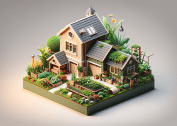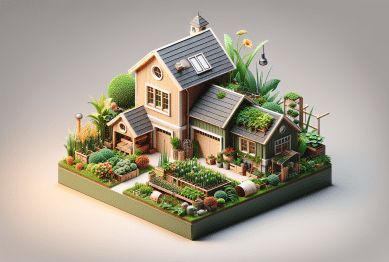Smart irrigation systems are changing how many homeowners manage their lawns and gardens. This in-depth guide explores smart irrigation technology, optimization tips, and real savings you could experience, all while helping you conserve water and maintain healthy plants.
What Makes Smart Irrigation Systems Different
Traditional sprinkler systems often run on fixed schedules, regardless of actual weather conditions. This leads to unnecessary water use—and higher bills. A smart irrigation system, on the other hand, uses weather data, soil moisture sensors, and adaptive timers to deliver water only when it’s needed. This approach not only promotes eco-friendly habits but also helps to reduce waste in significant ways. Sensor-based irrigation adapts to each home’s unique microclimate for better lawn and garden care. Some systems are even designed to integrate seamlessly with home gardening technology, making it simple to monitor and adjust settings remotely. Weather-based watering allows for precision that traditional timers simply can’t achieve.
By analyzing local and forecasted rainfall, modern smart irrigation controllers prevent unnecessary cycles. If rain is expected, watering schedules are automatically delayed. There’s no guessing or manual rescheduling required, which is a major relief for busy homeowners. This adaptability leads to less runoff and healthier root systems in landscapes. Overwatering can suffocate roots and contribute to fungal diseases in ornamentals or lawns. A combination of zone-based programming and soil moisture readings ensures every corner of the yard gets just as much water as it truly needs, creating optimal growing conditions and a lush, sustainable yard.
Another distinct benefit is how smart irrigation controllers can be managed from smartphones or tablets. Most brands offer mobile apps that give you instant access to watering data and scheduling. Remote control not only increases convenience but also supports efficient water management while on holidays or business trips. Some smart systems even offer compatibility with voice assistants and smart home platforms, taking the possibilities further. With these innovations, it’s easier to strike a balance between a beautiful landscape and sensible resource use—a win for both budget-conscious and eco-conscious individuals.
How Smart Irrigation Systems Help Save Water
Water conservation is a growing concern for homeowners and municipalities alike. Smart irrigation systems use a robust set of sensors and computerized algorithms to reduce overall consumption by responding intelligently to changes in weather, sunlight, and soil moisture. Unlike fixed-schedule timers, these advanced technologies prevent watering during rainy, windy, or cloudy days, minimizing waste and runoff. Water-efficient gardening isn’t just a trend—it’s a necessity in regions facing frequent drought. Households with smart systems often see clear reductions on their utility bills, highlighting real-world advantages supported by credible research (https://www.epa.gov/watersense/irrigation-controllers).
Another way to save water is zone customization. Not all parts of the yard require the same amount of hydration—shady beds, sunny lawns, and vegetable patches can have vastly different needs. Smart systems let users create distinct watering schedules for each planting zone. Automated cycle and soak functions allow moisture to penetrate deep, minimizing evaporation. Utilizing these features, homeowners can fine-tune watering times in response to local microclimate and plant types, leading to more resilient landscapes. These savings aren’t just anecdotal; studies show advanced irrigation controllers can save up to 30% more water compared to manual or traditional options (https://ucanr.edu/sites/WUCOLS/Irrigation_Scheduling/).
Some newer systems integrate with local water authority data, providing feedback on seasonal watering rules or restrictions to ensure compliance. This proactive guidance helps households remain environmentally responsible without having to monitor regulations themselves. Advanced scheduling platforms send reminders or suggestions when adjustments are required, further streamlining the gardening process. By acting on real-time data rather than a fixed calendar, smart irrigation represents a leap forward in sustainable yard management—and a step toward smarter, more resourceful home gardening.
Financial and Environmental Benefits
The financial impact of smart irrigation is tangible for many homeowners. Reduced water usage swiftly translates into savings on monthly bills. Most households using smart controllers report significant drops in both seasonal consumption and costs, especially during peak summer months. Over time, these savings can offset the initial investment in new hardware. Smart irrigation’s water-saving potential also means a landscape that looks better year-round, reducing the need for costly plant replacements due to disease or drought stress. Energy and water authorities often offer rebates or incentives for upgrading to water-efficient technology, making the transition even more attractive (https://www.epa.gov/watersense/rebate-finder).
Environmentally, smart irrigation technologies support local ecosystem balance by reducing unnecessary runoff that carries fertilizers and pesticides into waterways. This eco-friendly approach helps to preserve urban water quality, protect wildlife, and keep communities sustainable. There’s also less soil erosion, as careful water scheduling means land retains more nutrients and topsoil. These systems provide meaningful advantages for households hoping to contribute positively to their neighborhoods and planet. In drought-prone areas, conserving every drop of water matters—not just for personal budgets but for public health and natural resource management as well.
Another environmental plus: fewer hours spent running and maintaining sprinklers translates to shorter watering windows, which can help prevent fungal growth from overnight moisture. By empowering homeowners with data-driven tools and timely alerts, smart irrigation systems encourage proactive landscaping practices and healthier gardens. Taken together, the financial and environmental rewards make modernized irrigation hard to ignore for those seeking sustainability at home—and looking for effective ways to lower their ecological footprint with everyday choices.
Choosing the Right System for Your Home
There are many smart irrigation systems on the market, each offering unique features to meet various gardening or lawn care needs. When exploring options, consider the size of your landscape, the type of plants you grow, and connectivity preferences—like Wi-Fi, Bluetooth, or smart hub compatibility. Some systems offer robust integrations with weather services, while others focus on user-friendly interfaces or in-depth analytics. Leading brands provide solutions suited for complex, multi-zone landscapes as well as smaller, container gardens. Begin your search by listing out specific home gardening goals and technical requirements to find a good fit.
Think about installation. Some smart irrigation controllers are designed for DIY projects with step-by-step mobile setup, while others may require professional installation for larger properties. Assess compatibility with your existing sprinkler infrastructure to avoid the extra cost or hassle. Maintenance is another factor: look for systems that offer remote diagnostics, automatic firmware updates, and customer support. Alongside technical specifications, user reviews and independent resources can be extremely valuable for validating claims and understanding real-world performance (https://extension.unl.edu/statewide/douglas-sarpy/crops-horticulture/Smart_Irrigation_for_Homeowners.pdf).
Budget is an important consideration, but focus on long-term rather than upfront costs. Some utilities and municipal water providers run programs that help defray initial expenses. Prioritize systems that offer robust customization and future scalability, ensuring the technology can grow as your garden evolves or your needs change. Don’t overlook warranties or customer support—having dependable assistance makes ownership simple and stress-free. With some research, finding a smart solution that aligns with both environmental and financial goals becomes a straightforward part of planning an efficient, beautiful home garden.
Installation and Setup Tips
Many homeowners find installing a smart irrigation system surprisingly manageable, even with little technical background. Begin by reviewing the product’s manual and diagrams. Safety first: always turn off water and electrical connections before starting. Smart controllers typically replace your old timer but use existing wiring, making the swap easy. Make sure Wi-Fi signals are strong enough to cover outdoor devices. Optimal placement of rain and soil sensors ensures accurate data collection, which is vital for adaptive watering algorithms. Don’t forget to test the system after installation to confirm all solenoids and valves operate as intended.
Programming your new irrigation controller is straightforward with well-designed apps. Create schedules based on plant needs, landscaping zones, and seasonal variations. Experiment with manual and automatic modes to see how your yard responds to different settings. Many apps provide data on past water usage and upcoming forecasts, giving you the information required to make simple yet impactful adjustments. Properly labeling each zone is a practical step to avoid confusion in the future—especially for larger or multi-use gardens. Set reminders within the app to periodically review settings or replace batteries in wireless sensors for consistent performance.
If you’re unsure about setup, tap into the wide range of video tutorials and community forums offered by leading manufacturers and university extension offices. These resources provide troubleshooting and practical installation guidance. Don’t hesitate to consult professional landscapers or certified irrigation specialists for customized solutions—especially in complex or large-scale settings. Ongoing maintenance, such as unclogging sprinkler heads or recalibrating sensors, is straightforward and can be built into a regular gardening routine. With thoughtful preparation and the right approach, most households can successfully deploy and maintain a smart irrigation system that supports health, savings, and sustainability throughout the seasons.
Maximizing Benefits: Best Practices for Smart Watering
Setting up smart irrigation is only the beginning—ongoing optimization brings out its best advantages. Regularly review your system’s watering reports and adapt schedules based on observed trends and changes in plant growth. Leverage app features like weather-dependent adjustments, manual overrides during drought, and increased watering frequency for new plantings. Committing to routine inspections helps identify early issues like leaks, misaligned sprinkler heads, or dead sensors that can undermine performance and water savings. Remember, small changes in programming can make a large difference in plant resilience and utility bills.
One overlooked area is seasonal recalibration. As temperatures rise or daylight increases, lawns and gardens demand variable amounts of water. Update settings at least at the start of each major season, drawing on system data and weather forecasts. Don’t ignore feedback from plants themselves—yellowing leaves or soggy soil may signal needed adjustments. Supplement automated irrigation with good gardening habits, such as mulching beds to reduce evaporation and choosing drought-tolerant species for less thirsty landscapes. By combining technology with established gardening best practices, savings and landscape health both improve measurably (https://www.usgs.gov/special-topics/water-science-school/science/irrigation-water-use).
Lastly, take advantage of local water and gardening resources. Extension agencies, botanic gardens, and reputable horticulture websites regularly publish smart watering guides and research. Stay current with developments in irrigation technology—new updates or features are often available through manufacturer apps or support. Connecting with other local gardeners through clubs or online communities is another way to exchange insights and practical tips. By embracing continuous learning, you ensure your smart irrigation investment delivers long-lasting value for both your lawn and the environment.
References
1. United States Environmental Protection Agency. (n.d.). WaterSense for Irrigation Controllers. Retrieved from https://www.epa.gov/watersense/irrigation-controllers
2. Water Use Classification of Landscape Species. (n.d.). Smart Irrigation Scheduling. University of California Agriculture & Natural Resources. Retrieved from https://ucanr.edu/sites/WUCOLS/Irrigation_Scheduling/
3. United States Geological Survey. (n.d.). Irrigation Water Use. Retrieved from https://www.usgs.gov/special-topics/water-science-school/science/irrigation-water-use
4. Douglas-Sarpy County Extension, University of Nebraska–Lincoln. (n.d.). Smart Irrigation for Homeowners. Retrieved from https://extension.unl.edu/statewide/douglas-sarpy/crops-horticulture/Smart_Irrigation_for_Homeowners.pdf
5. United States Environmental Protection Agency. (n.d.). WaterSense Rebate Finder. Retrieved from https://www.epa.gov/watersense/rebate-finder
6. Texas A&M AgriLife Extension. (n.d.). Smart Irrigation Technologies. Retrieved from https://agrilifeextension.tamu.edu/library/lawns-gardens-landscaping/smart-irrigation-technologies/









